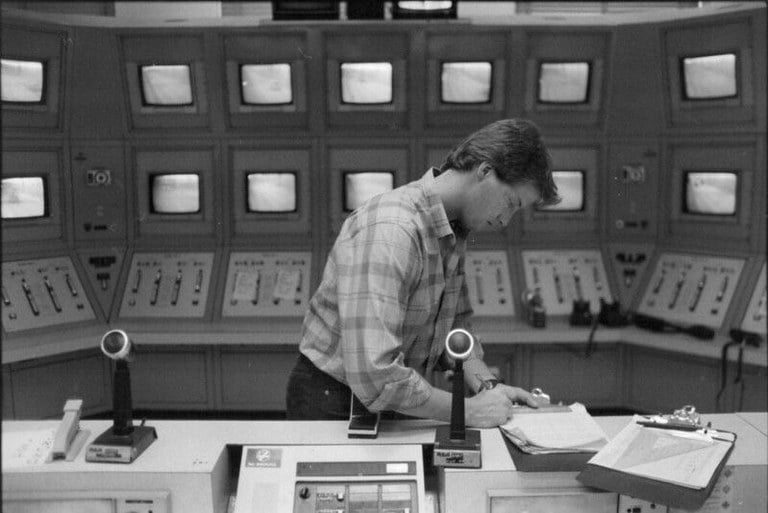Keeping Colorado Moving
Rod Mead reflects on three decades of traffic operations
CDOT traffic operations manager retiring after 32 years
By: Amber Shipley, CDOT Communications Manager for Southeastern Colorado
April 15, 2025
In 1993, Rod Mead was a 20-something country-music DJ looking for a way to pay his mortgage. He never imagined he would end up working at the Colorado Department of Transportation – let alone stay for over three decades.
Yet, today, he holds arguably one of the most impactful jobs at CDOT when it comes to the lives of everyday travelers. So how did he get from spinning records on the weekend to leading a team that serves as the eyes of Colorado’s roads? Believe it or not – his voice.
Before the internet, GPS systems, mobile phones, text alerts and digital overhead signs, CDOT’s primary way to inform the public about road conditions was through a recorded phone message. People had to call in to get updates on traffic, lane closures and other road conditions — and someone at CDOT had to continually record those messages, which changed fast and frequently. That someone was Rod Mead.
“You had two and a half minutes to record a message, and if you messed up or ran out of time, you had to do it over again,” recalls Rod. “They needed people who could talk quickly and clearly.”
With his background in radio, Rod was the perfect fit.
And so began Rod’s career at CDOT … which, just like the job itself, has been anything but predictable.

The eyes of Colorado’s roads
Today, Rod runs CDOT’s statewide traffic center in Golden, Colorado. He manages a team of 30 people who watch over 23,000 miles of roads on over 1,000 cameras, sharing real-time updates that help keep hundreds of thousands of drivers moving every day.
“We’re continually monitoring our roadways looking for things that cause turbulence on the roads,” explained Rod. “Could be anything from a pothole to someone dropping a ladder in the middle of a lane to a car crash.”
Once an issue is spotted, Rod and his team move fast to get the word out. They push updates across CDOT’s full network, ensuring drivers know what’s ahead before they hit the road. This includes posting alerts on overhead highway signs, updating travel apps, and notifying emergency services, hazmat and the media if necessary.
It’s a far cry from recording phone messages for eight hours a day, but Rod’s calm demeanor, sharp instincts and genuine compassion make him just as skilled at leading the charge today.
“It’s not just about helping the person that was in the crash and getting resources there as quickly as we can, but also being worried about and helping out the 20-30,000 people waiting for traffic to clear behind them,” said Rod. “That’s a big deal to me.”
From fax machines to fiber optics
As you can imagine, over his 32 years at CDOT, Rod has seen the agency evolve in every way — from its operations and communication methods to, perhaps most significantly, the way it uses technology to work smarter.

“When I first started at CDOT, the most advanced piece of technology we had was a fax machine,” said Rod with a laugh. “Now, I have people working for me who don’t even know what a fax machine is. It’s changed a whole lot over the years.”
What was once a system reliant on fax machines, recorded messages and word of mouth has transformed into one of the most advanced traffic management operations in the country. Today, CDOT manages one of the largest fiber optic networks of any state transportation department in the U.S., allowing teams to monitor traffic in real time, respond to incidents instantly, and keep travelers informed 24/7. These advancements haven’t just changed how people get information — they’ve redefined how CDOT operates.
But one thing hasn’t changed – the human element.
“We’re very much driven by technology, but the human hasn’t changed,” said Rod.
The people behind the scenes
Even with the most cutting-edge technology, Rod will tell you the backbone of CDOT’s operations has always been the people behind the scenes. The dedicated team members who use the tools at their disposal to ensure the safety and efficiency of Colorado’s roadways. From Golden, where Rod’s team works 24 hours a day, 365 days a year, it’s the staff who monitor the cameras, spot incidents and set the wheels in motion to deploy resources and share crucial information when it matters most.
Over the past three decades, Rod has seen it all — including bomb cyclone snowstorms, historic floods and semi-trucks dangling from a cliff. Not only that, he’s witnessed the impact of every incident, knowing that each one affects not just the people involved but everyone else on the road, too.
The idea of a team constantly watching the roads — sure, it might sound a little Big Brother-ish. But is that really a bad thing? Think of it like having a big brother who’s looking out for you — helping when you’re in danger, keeping you out of trouble and stepping in to help clean up when things go wrong.
“I feel like my staff and I really make a difference in people’s lives and what they do every single day,” said Rod.
Approaching the exit
It’s that variety and impact that has kept Rod at CDOT for more than three decades. But every road must eventually come to an end, and Rod’s is no exception. 2027 is on the horizon, and after 33 years, 1,000+ snowstorms, seven executive directors, and thousands of ladders on the highway, Rod will retire. If you’ve ever been helped by CDOT’s Courtesy Patrol, relied on real-time traffic updates, or had emergency crews respond quickly after a crash, chances are, you have Rod and his team to thank.
So it might be a bit premature, but thank you, Rod, for three decades of service, compassionate leadership, and for always keeping Colorado moving. Wishing you smooth roads ahead in your next adventure!
About the Author:

